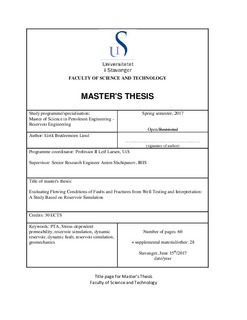| dc.contributor.advisor | Shchipanov, Anton | |
| dc.contributor.advisor | Larsen, Leif | |
| dc.contributor.author | Lund, Eirik Brødremoen | |
| dc.date.accessioned | 2017-10-26T09:03:33Z | |
| dc.date.available | 2017-10-26T09:03:33Z | |
| dc.date.issued | 2017-06-15 | |
| dc.identifier.uri | http://hdl.handle.net/11250/2462300 | |
| dc.description | Master's thesis in Petroleum engineering | nb_NO |
| dc.description.abstract | The scope of the thesis was inspired by the studies of CO2 storage in saline aquifers containing faults conducted at IRIS within the ENOS project1. In storage site evaluations, assessing and preventing leakage from the injection site is a necessary component. Many saline aquifers contain faults, which can act as sealing boundaries or as reservoir fluid conductors if reactivated, e.g. due to CO2 injection and reservoir pressure buildup. Evaluation and monitoring of flowing conditions on faults are therefore crucial for preventing or limiting CO2 leakage from injection sites.
Fluid production and injection in porous rocks cause changes of pore pressure and in-situ effective stresses, having an impact on rock permeability and reservoir features like faults and fractures. In reservoir simulation, such dynamic reservoir behaviour may be addressed via introducing stress-dependent functions for permeability and fault and fracture conductivities. In general, a coupling between reservoir flow simulators and geomechanical modelling is necessary to address the changes of the pore pressure and the effective stresses interconnected via stress-dependent reservoir properties. However, such a coupling is time-consuming, so the conventional approach is to assume these properties to be pressure-dependent and ignore total reservoir stress change. Using analytical geomechanics to relate effective stress changes to pressure changes may work as an alternative approximation located between the extreme approaches described above.
The first part of the thesis focuses on the comparison of different models to account for geomechanical effects based on the uniaxial strain approximation relating pressure and stress changes. This results in different pressure functions: (1) ignoring total stress changes, and accounting for (2) local and (3) global stress changes. Conventional uncoupled reservoir simulators have functionality for implementing the models (1) and (2), but cannot cover the model (3). A research code for simulating 1D radial single-phase flow with stress-dependent permeability and all three models implemented has been developed in MS Excel VBA and tested via comparison with the Eclipse simulator for the models (1) and (2). Using the code, all three models have been compared for different boundary conditions showing what applying the models (1) and (2) give upper and lower limits for stress and permeability forecasts, while the model (3) forecast is located in between. This argues that using the models (1) and (2) in reservoir simulations can help to cover the whole uncertainty range for effects related to geomechanics at given geomechanical parameters and under the assumptions mentioned above.
A single well water injection into a saline aquifer near a fault was numerically simulated and studied in the second part of the thesis. The study employed a combination of analytical and numerical simulations in Saphir and Eclipse. A possibility of detecting fault reactivation from interpreting well injection and shut-in pressure transients has been confirmed. Here, reactivation of initially sealing fault (with zero permeability along and across the fault) was related with intensive reversible growth of permeability along the fault after a threshold pressure. Pressure Transient Analysis (PTA) of simulated pressure responses has illustrated the possibility to detect fault reactivation from both injection and shut-in responses, whilst the combination of interpreting both responses gives the most reliable detection. It was also observed in the simulations that the intensity of permeability increase along the fault seems to have a minor impact on the pressure derivative for chosen fault orientation with respect to the well. Therefore, monitoring pressure transient response during injection in site operations can give a good indication of fault reactivation. A comparison of two cases with fault reactivation by the models (1) and (2) applied to a fault permeability function (e.g. evaluated from laboratory experiments) has illustrated a possible uncertainty range related with to description of geomechanical effects in reservoir simulations.
The results of this thesis will be used in further activities within the framework of the ENOS project1 at IRIS. The results of this reservoir simulation study and outcomes of PTA for faulted reservoirs would help in the development of a PTA-based methodology for the monitoring of dynamic fault behaviour at pilot injection sites around Europe.
1 ENOS (Enabling Onshore CO2 Storage). The project is funded by the European Union’s Horizon 2020 research and innovation programme under grant agreement No. 653718. www.enos-project.eu | nb_NO |
| dc.language.iso | eng | nb_NO |
| dc.publisher | University of Stavanger, Norway | nb_NO |
| dc.relation.ispartofseries | Masteroppgave/UIS-TN-IPT/2017; | |
| dc.subject | petroleumsteknologi | nb_NO |
| dc.subject | petroleum engineering | nb_NO |
| dc.subject | PTA | nb_NO |
| dc.subject | reservoir simulation | nb_NO |
| dc.subject | dynamic reservoir | nb_NO |
| dc.subject | dynamic fault | nb_NO |
| dc.subject | geomechanics | nb_NO |
| dc.subject | reservoarteknologi | nb_NO |
| dc.subject | stress-dependent permeability | nb_NO |
| dc.title | Evaluating Flowing Conditions of Faults and Fractures from Well Testing and Interpretation: A Study Based on Reservoir Simulation | nb_NO |
| dc.type | Master thesis | nb_NO |
| dc.subject.nsi | VDP::Teknologi: 500::Berg‑ og petroleumsfag: 510::Petroleumsteknologi: 512 | nb_NO |
